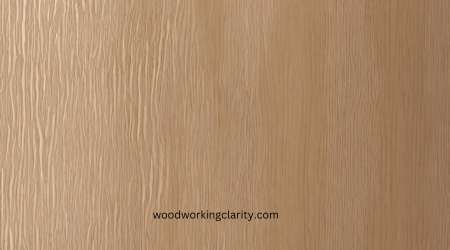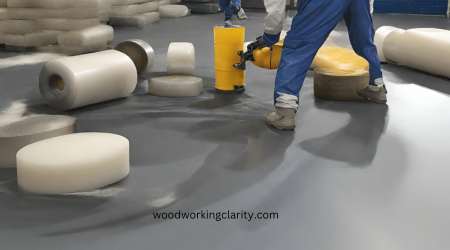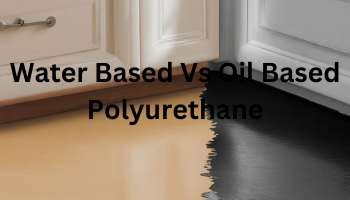When it comes to wood finishes for floors, polyurethane stands head and shoulders above the competition.
After all, polyurethane is a sturdy, reliable, almost unbreakable coat that won’t let you down. But, unfortunately, that doesn’t make choosing polyurethane any easier.
You still have the issue of which type to choose. The battle of water-based vs oil-based polyurethane is a delicate and tricky business, so it’s my job to simplify it for you.
Water-Based vs Oil-based Polyurethane: Which Is Better?
Durability. Oil-based polyurethane is far more resistant to wear and tear than its water-based cousin, as it consists of abundant Volatile Organic Compounds (VOCs).By introducing certain chemicals, you can make the finish of your product tougher and ensure it has a longer lasting effect.
What’s the Difference Between Water Based and Oil Based Polyurethane
Here’s how to tell if polyurethane is oil or water-based.
What is water based polyurethane?

As the name implies, water-based polyurethane uses water as its base or primary agent instead of oil (solvents) to carry the polyurethane solids.
As a result, it is a milky-looking substance that dries crystal clear. Water-based polyurethane was once denigrated as not being durable. However, its manufacturer has improved a lot in the last decade.
Now, many flooring professionals prefer water-based polyurethane to almost any other type of finish when durability is critical.
Water-based polyurethane can be used on any woodworking project and various finishes and stains but is most commonly used on hardwood floors.
This finish is wood raising, so you need to apply more coats to get a smooth finish. Water-based polyurethane has grown in popularity because it has a low odor, dries quickly, and is easy to apply.
Related: Spar urethane vs Polyurethane
What is oil-based polyurethane?

This type of polyurethane uses mineral solvents or petroleum as the base to carry the polyurethane solids.
It was the original polyurethane, and it remains the favored option for many OG woodworkers. Oil-based poly is a brownish-looking liquid that appears thicker than water.
When applied properly, oil-based polyurethane finish has an amber hue that continues to darken over its lifespan, which could be a decade or more with proper care.
This finish is also very scratch and chemical resistant. Hence, it is well-suited for use on tables, countertops, floors, and furniture that will see a lot of traffic.
Oil-based poly is popular because it enhances the natural color of hardwood floor, is water-resistant, and is versatile.
Water-based polyurethane pros and cons
Pros
- It dries crystal clear
- It is easy to apply
- It dries quickly
- It has a very low odor and releases much fewer VOCs
Cons
- It is grain-raising, so it requires more coats
- It is relatively expensive
Oil-based polyurethane pros and cons
Pros
- It has an amber hue that makes hardwood floor shine
- It is very durable
- Surface scratching resistant
- It requires a few coats
Cons
- It has a strong smell
- It takes a long time to dry
Which is Better – Oil based or Water based Polyurethane?
From the brief descriptions so far, you have probably already begun to make judgments on the two products.
First, however, you must fully understand how different these “twin products” are to make the right decision, including the question: can you put water-based poly over oil-based poly?
Sure, life would be easier if there was only one type of polyurethane, but water-based poly was developed for a reason.
In the in-depth comparison below, you will decide which type of polyurethane to use depending on the project you are working on.
See Also: Sanding sealer vs polyurethane
1. Oil vs water based polyurethane – Color
The first and main difference between these two products is the color. As mentioned earlier, water-based polyurethane looks milky white in the can.
Even as you begin to apply it, parts of it will still look like white washed hardwood floor, but it won’t take long before it begins to clear.
The water-based finish dries crystal clear like a light-colored maple on every surface unless the wooden object has white paint.
Unfortunately, for some reason, water-based poly tends to have a very yellow-ish tone on white paint, so most manufacturers warn against it.
On the other hand, oil-based polyurethane finishes look brownish in the can. However, it immediately gives the surface a darker shade or an amber hue when applied to hardwood floor.
This can bring out the beauty of the grain and make any dull wood color come alive. But unfortunately, as the oil-based finish ages, it grows slightly darker yearly.
While this has advantages, it is a frequent source of frustration for new woodworkers. Oil-based poly is a clear coat, and manufacturers often label it as drying clear.
Of course, when you hear a topcoat dries clear, you don’t expect it to change the color of your hardwood floor.
So, to make it clear (pun intended), ‘dries clear’ is used to describe oil-based finishes, while ‘dries crystal clear’ is for water-based finishes.
The question you then need to answer is, do you want the color of your wood to change, or do you want to keep it as it is? Frankly, this is a personal choice and will depend on the project.
I was inclined to give water-based polyurethane the edge here because it can be used on any hardwood floor. Still, that extra pop you get from oil-based poly is gorgeous.
Verdict: tie (it’s a matter of personal preference)
2. Oil vs water based polyurethane – Durability
This is one section that had a clear winner for decades. When polyurethane coatings were first invented in the 1950s, there was only one kind. So naturally, all the research and development went into perfecting oil-based polyurethane.
So, by the time water-based poly came on the scene in the early 1990s, people have already had decades of witnessing the durability of oil poly. But, of course, as with all new quality products, there were flaws.
And so, if you read articles written as far back as the mid-2010s, you will find that the consensus agreement is that oil-based polyurethane is way more durable.
Many people still carry on that assertion today. However, the reality is that new water-based polyurethanes are just as good as oil-based alternatives.
While older water coats had a lifespan of 6 to 7 years, modern ones can last as long as 10 years, just like oil poly. In addition, both products resist scratches and scuffs, are water and heat-resistant.
However, oil-based poly is arguably more durable in one aspect: chemical resistance. When chemicals spill on water based finishes, they often change color.
So, basic items like household products or pet urine could leave a whitish blotch on your water-based topcoat.
Of course, the polyurethane won’t be damaged and will still protect your hardwood floor, but you probably won’t like how it looks.
It is worth mentioning that some water-based products will revert to remain clear in a few days, while some don’t have this problem at all.
Nevertheless, watch out for this when buying quality water-based poly.
Verdict: oil-based polyurethane is more durable
3. Water vs oil-based polyurethane – Application methods

Every experienced flooring contractor knows that having a good product is useless if you can’t correctly apply it. That is why the application method is critical when choosing between these two types of poly.
The best tool for applying water-based finish is a synthetic bristle brush. When applying the finish on wood floors, it is best to use a roller, preferably a micro fibre roller.
Water-based polyurethane can also be applied using a high volume low oil-based floor finish can also be applied using the same tools, though different textures and qualities.
Instead of a synthetic brush, you need a natural bristle brush to apply oil-based poly. Natural brushes are made from animal hair to hold more of the thicker poly than a nylon brush.
Oil-based topcoats can also be sprayed and applied with a lambswool applicator, roller, and aerosol. The one application method unique to oil-based poly is wipe-on. (Also, find out how to make wipe on polyurethane at home.)
This is a fast and easy method of applying this type of polyurethane on small projects or hard-to-reach areas. Oil-based polyurethane can also be applied with a wider variety of rollers without bubbling.
Verdict: oil-based polyurethane
4. Oil based vs water based polyurethane – Number of coats
Okay, so oil-based polyurethane finishes can be applied with more tools, but do they make it easier to apply? Not necessarily.
When considering the ease of application, we need to factor in the tools you need to apply the oil-based products, skill level involved, number of coats, and the clean-up process.
We will discuss these separately. As water-based poly uses water as its base, it is lighter and easier to spread.
However, it also means applying more coats to form a protective layer. The good thing is that you don’t necessarily need to sand between coats.
One thing to be wary of is that the water base tends to raise the wood grain. If that happens, you need to sand between coats and require considerably more layers to smooth it.
On the other hand, oil-based polyurethane is thick, so three coats are usually enough to protect your wood for years, while water-based might require twice as many coats.
Of course, the downside is you must always sand between the oil coats. The main reason is to eliminate dust nibs, brush streaks, roller lint, and bubbles.
Besides that, abrading the surface helps subsequent layers to adhere better.
Verdict – Oil-based polyurethane
5. Oil-based polyurethane vs water based– Drying time
Passing a verdict on the previous section might be a little misleading, and here is why. While oil-based poly requires fewer coats, it takes much longer for each coat to dry.
Therefore, you should also think about how quickly it takes you to complete the entire task unless, of course, you are applying only one coat, which rarely happens.
Oil-based poly takes between 12 to 24 hours to dry before you can apply another coat. If you’ve been working with natural tung oil, you might think that’s not bad, but it is ridiculous compared to water-based poly, which only needs 4 to 6 hours.
So, it could take you a few days to apply three coats of oil-based polyurethane. In contrast, you can apply five coats of water-based poly in half the time.
However, if you’re using fast-drying polyurethane finishes, they could be dry to the touch and ready for a recoat for 6 hours. But of course, even fast-drying water based polys dries quicker in 2 hours.
After applying the last coat, water-based polyurethane will need 21 days to cure fully, while oil-based takes 30 days.
Verdict – water-based polyurethane by a landslide
6. Water-based polyurethane vs oil – Skill level
Before you get excited about one type or another, we need to consider the other factors that affect the ease of application.
Due to how quickly water-based polyurethane dries, you don’t have as much time to make corrections. As a result, you require more skill to use water-based poly than oil-based poly.
However, some argue the opposite because oil-based polyurethane attracts more dust nibs. However, you can guard against that by keeping your environment clean.
It’s also not a substantial factor as you need to sand the last coat of polyurethane anyway, eliminating the nibs.
When you are proficient, you will most likely prefer water-based polys for hardwood floors because you can finish the job quickly. But before you get there, you might struggle with puddles.
While both types are self-leveling, water-based polyurethane often dries too quickly before it does, leaving brush streaks.
Unless you are using fast-drying oil-based polyurethane or one-coat poly, you won’t have that issue.
Now, find out the polyurethane on hardwood floors waiting duration.
Verdict – oil-based polyurethane by a nose
7. Water-based polyurethane vs oil based – Cleaning
Water-based polyurethane is one of the easiest finishes to clean. All you need is water and a bit of dish soap. In fact, some manufacturers boast that you can rinse off your brush or other applicators using just water, but take that with a pinch of salt.
Despite what they say, I’d recommend you always use soap after rinsing out. Even though water-based poly dries quickly, it is still easy to get rid of one coat.
On the other hand, oil-based poly needs turpentine or mineral spirits, water, and dish soap to eliminate every trace of the product.
This process can be time-consuming yet necessary. If you don’t clean your utensils properly, they won’t last very long.
Verdict – Water-based polyurethane wins
8. Water-based vs oil-based polyurethane floor finish – Toxicity
Finally, we have arguably the only thing that matters, but we’ll get there in a minute.
All oil-based products contain a lot of chemicals. The more the chemicals, the more volatile organic compounds (VOCs) that substance releases.
VOCs are the reason why indoor air quality has deteriorated drastically in recent times. Oil-based polyurethanes release so many VOCs; manufacturers were forced to make water-based alternatives.
VOCs are a known carcinogenic, and responsible for many illnesses and respiratory conditions. As such, oil-based polyurethane should not be applied to children or pets.
On the other hand, water-based floor releases significantly fewer VOCs. So, why is this the only thing that matters?
The government has been cracking down on indoor VOCs and banning products above a certain threshold.
If oil-based polyurethanes cannot be kept below that level, they will soon cease to exist. Besides VOCs, oil-based polys also have a strong odor, so you need to wear a respirator when applying.
Besides being harmful to people and pets, it is also toxic to the environment. The good thing about polyurethane is that it no longer emits VOCs when it dries.
Another harmful product in polyurethanes is isocyanates, of which oil-based polys also emit more.
Fortunately, some companies are working on isocyanate-free polyurethane, which will also reduce VOCs.
But until then, there is one clear winner.
Verdict – water-based polyurethane takes the crown.
FAQs
Which is more durable water-based polyurethane or oil-based polyurethane?
Both types of polyurethane are equally durable. While there was once a time when water-based polyurethanes were inferior to oil-based polyurethane, that has changed within the past decade.
Now, both types of polyurethane can protect your wood for up to a decade if taken care of properly.
Can you Apply Water-Based Polyurethane over Oil-based Stain?
Yes, it’s possible to do so. However, if the stain is old and has fully cured out, then this may not work. Check our quick guide on applying water-based poly over oil stains.
Is water-based polyurethane any good?
Yes, water-based polyurethane is excellent, especially for hardwood floors. You can expect it to last for years if you apply water-based poly correctly and with the right number of coats.
Water-based polyurethane is perfect for floors as it can be applied quickly and dries quickly. It is also scratch and scuff-resistant, waterproof, and dries as hard as oil-based poly.
How many coats of polyurethane should I apply?
You need at least three layers of polyurethane to provide a protective coat. When applying water-based polyurethanes on surfaces that will see a lot of traffic, you should apply between 5 to 7 coats or whatever the manufacturer suggests. You may need more than three coats for water-based poly because it tends to raise the grain. Keep applying more coats until the surface is level and smooth.
Do I need to sand between coats of polyurethane?
Yes, you need to sand between coats of oil-based polyurethane. However, it is possible to apply subsequent coats of water-based polys if there are no dust nibs, streaks, or bubbles and if you do it reasonably quickly.
Oil-based polyurethane needs to be scoured for subsequent coats to adhere properly. Otherwise, the coat might peel.
Read also: What happens if you do not sand between coats of polyurethane?
Can I thin polyurethane?
Yes, you can thin polyurethane. Thinning polyurethane makes it easier to use as it levels better and brush marks disappear easier.
You may also choose not to thin polyurethane, especially water-based polyurethane. Thinning oil-based polyurethane enables it to dry slightly quicker while also making your product last longer.
How long does it take polyurethane to dry?
Water-based polyurethane dries in 4 to 6 hours, while oil-based polyurethane takes 12 to 24 hours. Thus, fast-drying water-based polyurethane dries in roughly half the time for both products.
After the final coat, water-based polyurethane is ready to walk on in 24 to 72 hours and fully cures in 21 days. Oil-based poly is ready for light use in 3 to 7 days and fully cures in 30 days.
For more information, check out this quick guide on how long does polyurethane take to dry on wood furniture.
Is polyurethane toxic?
Yes, polyurethane is toxic. However, that does not mean you are putting anybody at risk. As long as you apply polyurethane the right way, whether oil-based or water-based, you and everybody around the product will be safe.
It is advisable not to apply oil-based polyurethane around children or pets. Water-based poly emits fewer toxic gasses, and some are odorless, making them safer for domestic use.
Once polyurethane has fully cured (21 days for water-based and 30 days for oil-based), it is no longer toxic. Learn more about polyurethane toxicity to humans in our guide.
Water Based vs Oil based Polyurethane Verdict.
With all the preamble out of the way, it’s time to pick a winner between water-based polyurethane Vs. Oil-based polyurethane. However, you might have realized that it is not a straightforward process.
You may need to choose polyurethanes depending on the project you are working on: size, wood, duration, and look.
Water-based polyurethane verdict
Given how quickly it dries, water-based poly is best for engineered hardwood floors and other large projects.
While water based polyurethane costs a bit more than oil-based polyurethane, the prompt application means you finish the job quicker and get paid faster.
However, if you’re not confident about your skills or prefer to work slowly, water-based poly isn’t for you.
Finally, if you prefer to keep the stained hardwood floor color as it is or want light-colored wood, you can only use water-based polyurethane.
If you’ve found your winner, read our guide to the top five water-based floor polyurethane.
Oil-based polyurethane verdict
The original polyurethane has been a life-saver, or should I say wood-saver, for decades and will continue to be so.
Oil-based polyurethane is excellent when you need a highly durable product with minimal coats. Oil-based polyurethane is also perfect for dull woods that need a pop of color.
Also, if you are on a budget and working on a project that isn’t time-sensitive, an oil-based polyurethane floor comes in very handy.
Of course, if you have toddlers on the premises and there is no way to cordon off the area, then please stick with water-based polyurethane.
If you are team oil, see this review and guide to the top rated oil-based poly for hardwood floors.


I am getting ready to refinish my floors. What do recommend for a kitchen floor water or oil base.
oil has a very strong smell that will linger but is very durable. We used water-based (Bona) and it turned out great. They’re probably equal in quality but water-based has no odor and we have kids and pets, so we went with that.